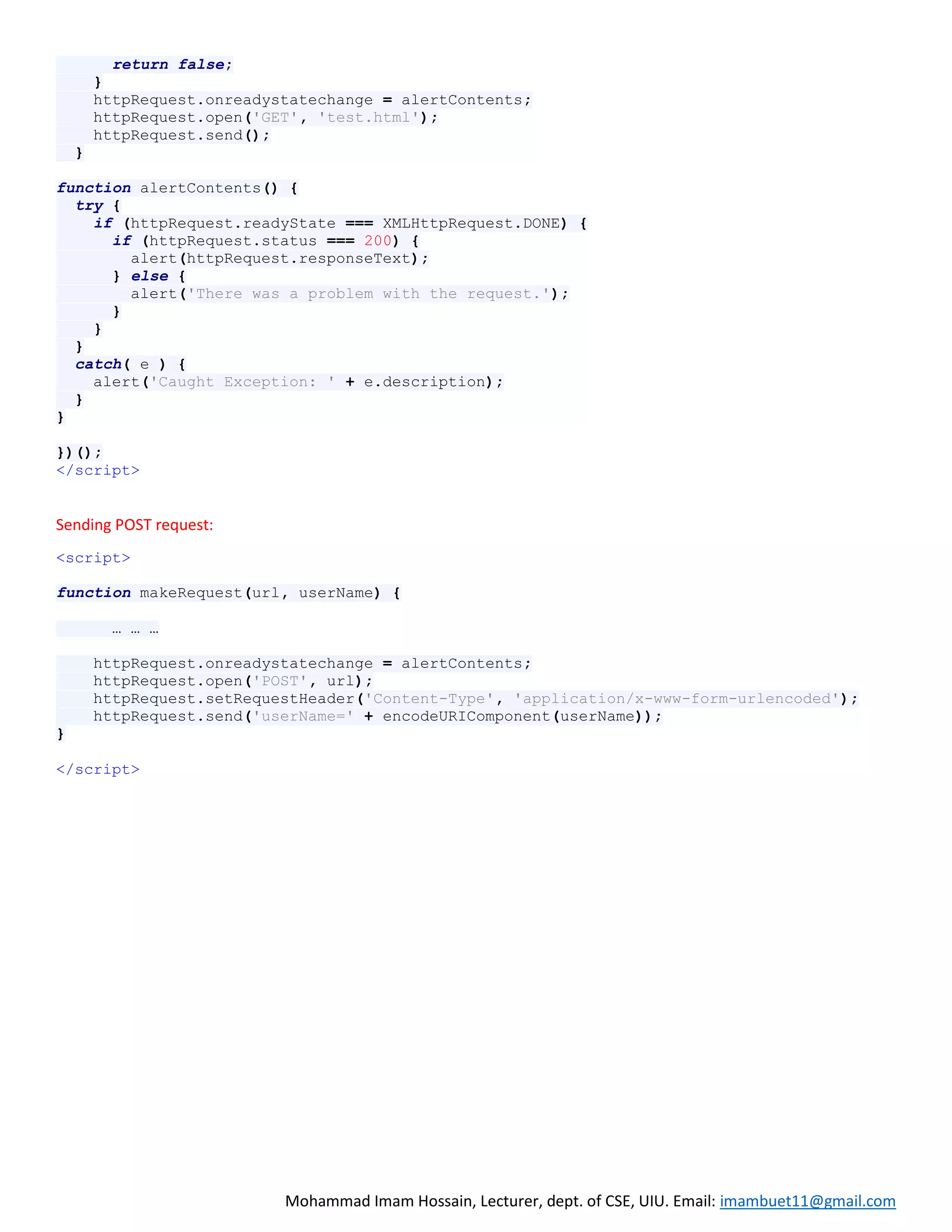AJAX allows web pages to be updated asynchronously by exchanging data with a web server behind the scenes. It enables web pages to update just part of a page without disrupting what the user is doing. JSON is commonly used as a data format for AJAX requests, as it allows JavaScript objects to be converted to and from text that can be sent over the network. The XMLHttpRequest object is used to send and receive data from a web server asynchronously.
![Mohammad Imam Hossain, Lecturer, dept. of CSE, UIU. Email: imambuet11@gmail.com AJAX (Asynchronous Javascript And XML) AJAX is the use of the XMLHttpRequest object to communicate with servers. It can send and receive information in various formats, including JSON, XML, HTML and text files. The two major features of AJAX allow you to do the following: o make requests to the server without reloading the page o receive and work with data from the server It enables a Web page to update just part of a page without disrupting what the user is doing. XMLHttpRequest class: Properties Methods readyState -- returns the state of the request 0 -> UNSENT [open() not called yet] 1 -> OPENED [open() has been called] 2 -> HEADERS_RECEIVED [send() has been called] 3 -> LOADING [responseText holds partial data] 4 -> DONE [the Operation is complete] setRequestHeader(header, value) --sets the value of an HTTP request header, must call it after open() but before send() methods getResponseHeader(header) --returns the string containing the text of a particular header’s value onreadystatechange -- an eventhandler that is called whenever the readyState attribute changes open(method, url) --initializes a request status --returns the numerical HTTP status code of the XMLHttpRequest’s response send(req_body) – req_body is optional --sends the request to the server responseType --the type of the data contained in the response “” -> text (default) json -> json object document -> HTML document blob -> blob object containing the binary data abort() --aborts the request if it has already been sent responseText --contains response to the request as text or null if the request was unsuccessful Events: abort, error, load, loadend, loadstart, progress, timeout response --returns the reponse’s body content as a document, text, JSON, blob depending on the value of the request’s reponseType property. Sending GET Request: <button id="ajaxButton" type="button">Make a request</button> <script> (function() { var httpRequest; document.getElementById("ajaxButton").addEventListener('click', makeRequest); function makeRequest() { httpRequest = new XMLHttpRequest(); if (!httpRequest) { alert('Giving up :( Cannot create an XMLHTTP instance');](https://image.slidesharecdn.com/ajaxjsonlatest-200324194323/75/Web-11-AJAX-JSON-PHP-1-2048.jpg)

![Mohammad Imam Hossain, Lecturer, dept. of CSE, UIU. Email: imambuet11@gmail.com JSON (Javascript Object Notation) When exchanging data between a browser and a server, the data can only be text. JSON is text that is used to transmit structured data over network connection. Format: 1. JSON objects are surrounded by curly braces {} 2. JSON objects are written in key/value pairs 3. Keys must be double quoted strings 4. Values can be null, true, false, JSONNumber, JSONString, JSONObject, JOSNArray 5. Keys and values are separated by a colon 6. Each key/value pair is separated by a comma For example, var myobj = { “name” : ”John”, “age” : “30”, “cars” : [ { “name” : ”Ford”, “models”: [“fiesta”,”focus”,”mustang”] }, { “name”:”BMW”, “models”:[“320”,”x3”,”x5”] }, { “name”:”Fiat”, “models”:[“500”,”Panda”] } ] }; JSON Methods: Javascript PHP JSON.stringify() converts a JavaScript object or value to a JSON string. console.log(JSON.stringify({ x: 5, y: 6 })); // expected output: ‘{"x":5,"y":6}’ json_encode() — Returns the JSON representation of a value <?php $arr=array('a'=>1,'b'=>2,'c'=>3,'d'=>4, 'e'=>5); echo json_encode($arr); ?> JSON.parse() parses a JSON string, constructs the JavaScript value or object described by the string. var json = '{"result":true, "count":42}'; obj = JSON.parse(json); console.log(obj.count); // expected output: 42 json_decode() -- takes a JSON encoded string and converts it into a PHP variable. <?php $json = '{"a":1,"b":2,"c":3,"d":4,"e":5 }';](https://image.slidesharecdn.com/ajaxjsonlatest-200324194323/75/Web-11-AJAX-JSON-PHP-3-2048.jpg)
